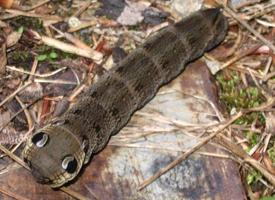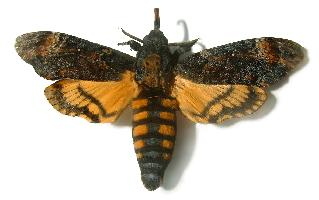
Poids et mesures
| Longueur | de 50 à 65 mm |
|---|
Description de l'animal
The Elephant Hawk Moth (Deilephila elpenor) is a captivating creature that belongs to the Sphingidae family, known for its unique and vibrant appearance. This moth, primarily found in the British Isles, but also widespread across Europe and parts of Asia, is a marvel of nature, showcasing a blend of fascinating behaviors and distinctive physical characteristics.Adult Elephant Hawk Moths display an enchanting color palette on their wings, combining shades of pink and olive green in a way that is not only beautiful but also serves as an effective camouflage among the flowers and foliage where they feed and rest. The wingspan of an adult can reach up to 60mm, making it one of the larger moth species encountered in its native habitats. The forewings are elongated and streamlined, perfect for fast, agile flight, while the hindwings bear the vibrant pink that becomes visible during flight or when the moth is startled, serving as a deterrent to predators.
The common name "Elephant Hawk Moth" derives from the caterpillar's resemblance to an elephant's trunk. The caterpillar stage of Deilephila elpenor is as remarkable as the adult moth, featuring a plump, elongated body that can exhibit various colors, from green to brown, depending on environmental factors. A distinctive characteristic of the caterpillar is its eye-like markings, which serve as a defense mechanism to scare off predators. The "trunk" is actually an extended part of the caterpillar's mouth, used to feed on its favorite plants, such as willowherb and bedstraw.
The life cycle of the Elephant Hawk Moth is a fascinating process. The moth lays its eggs on the underside of leaves, which hatch into caterpillars ready to feed and grow. After a period of rapid growth, the caterpillar then finds a suitable spot in the soil or leaf litter to pupate. The pupa stage can last over the winter, with the adult moth emerging in late spring or early summer. This cycle of transformation, from egg to caterpillar, pupa to adult moth, is a classic example of complete metamorphosis, showcasing nature's ability to change and adapt.
The Elephant Hawk Moth is nocturnal, primarily active during the night when it feeds on nectar from a variety of flowers, using its long proboscis to reach into deep flowers - a behavior that also aids in the pollination of these plants. This moth is particularly attracted to flowers that open or are more fragrant at night, such as honeysuckle.
Despite its striking appearance, the Elephant Hawk Moth is elusive, and encountering one is always a delightful surprise for nature enthusiasts. Its presence in a garden is a sign of a healthy, biodiverse ecosystem. The Elephant Hawk Moth, with its vibrant colors, intricate life cycle, and role in pollination, is a testament to the complexity and beauty of the natural world.
Animaux similaires
Nouvelles photos d'animaux
Top 10 des animaux
- Dolphin gull (Leucophaeus scoresbii)
- Japanese macaque (Macaca fuscata)
- Stone loach (Barbatula barbatula)
- Greek tortoise (Testudo graeca)
- Russian tortoise (Testudo horsfieldii)
- Galápagos tortoise (Geochelone nigra complex)
- Diana monkey (Cercopithecus diana)
- Moustached guenon (Cercopithecus cephus)
- Common flying dragon (Draco volans)
- Galápagos penguin (Spheniscus mendiculus)
